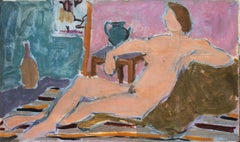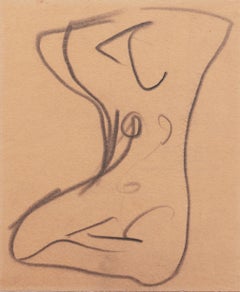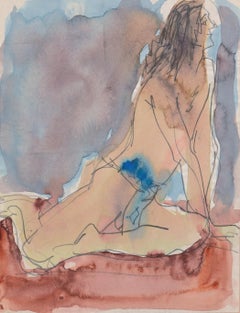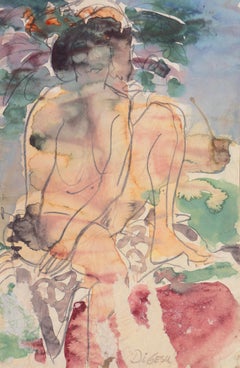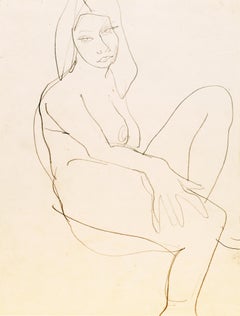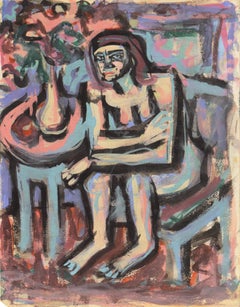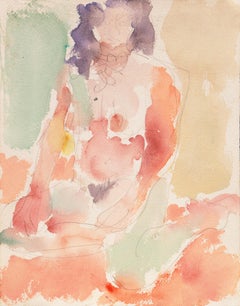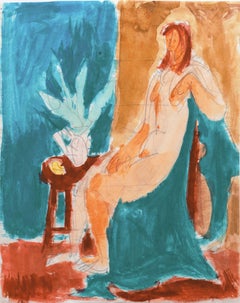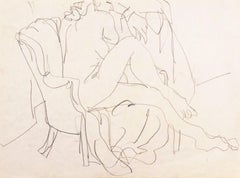Seated Nude By Victor Di Gesu
1950s Post-Impressionist Nude Paintings
Canvas, Oil, Board
1950s Post-Impressionist Nude Drawings and Watercolors
Paper, Graphite
1950s Post-Impressionist Nude Drawings and Watercolors
Paper, Graphite, Watercolor
Victor Di Gesu'Seated Nude, Blue Loincloth', Paris, Louvre, Salon d'Automne, LACMA, SFAA, Circa 1955
1950s Post-Impressionist Nude Drawings and Watercolors
Paper, Watercolor, Gouache, Graphite
1950s Post-Impressionist Nude Drawings and Watercolors
Paper, Graphite
1940s Post-Impressionist Figurative Paintings
Oil, Masonite
1950s Post-Impressionist Figurative Paintings
Paper, Watercolor, Gouache
1950s Post-Impressionist Figurative Drawings and Watercolors
Paper, Watercolor
Recent Sales
1950s Post-Impressionist Nude Drawings and Watercolors
Paper, Watercolor, Graphite
1950s Post-Impressionist Figurative Drawings and Watercolors
Graphite, Paper
1950s Post-Impressionist Figurative Drawings and Watercolors
India Ink, Mulberry Paper
People Also Browsed
1960s Post-Impressionist Still-life Paintings
Oil, Paper
1950s Post-Impressionist Figurative Paintings
Paper, Oil
1950s Post-Impressionist Figurative Paintings
Paper, Oil, Graphite
1950s Post-Impressionist Figurative Paintings
Canvas, Oil
Victor Di Gesu for sale on 1stDibs
Victor di Gesu first attended the Chouinard Art School before moving to Paris, where he studied with André Lhote at the Académie de la Grande Chaumière. He subsequently attended the Escuela de Bellas Artes in Barcelona before furthering his studies in Italy. Returning to California, he worked with a variety of artists, including F. Tolles Chamberlain and Maynard Jepson. An intuitive colorist, Di Gesu’s classical training and scientific research into color theory helped him create vivid yet harmonious works which, while reminiscent of Matisse and Gauguin, retained a verve and spontaneity that was uniquely his own. A prolific artist, Di Gesu was the recipient of numerous medals and juried awards, both in the United States and France. He was the winner of the Prix Othon Friesz Prize. He exhibited widely and with success, including at the Louvre Museum and the Exposition des Artistes Etrangeres in Paris, the San Francisco Museum of Modern Art and the Los Angeles County Museum of Art.
A Close Look at Post-impressionist Art
In the revolutionary wake of Impressionism, artists like Vincent van Gogh, Georges Seurat, Paul Cézanne and Paul Gauguin advanced the style further while firmly rejecting its limitations. Although the artists now associated with Postimpressionist art did not work as part of a group, they collectively employed an approach to expressing moments in time that was even more abstract than that of the Impressionists, and they shared an interest in moving away from naturalistic depictions to more subjective uses of vivid colors and light in their paintings.
The eighth and final Impressionist exhibition was held in Paris in 1886, and Postimpressionism — also spelled Post-Impressionism — is usually dated between then and 1905. The term “Postimpressionism” was coined by British curator and art critic Roger Fry in 1910 at the “Manet and the Postimpressionists” exhibition in London that connected their practices to the pioneering modernist art of Édouard Manet. Many Postimpressionist artists — most of whom lived in France — utilized thickly applied, vibrant pigments that emphasized the brushstrokes on the canvas.
The Postimpressionist movement’s iconic works of art include van Gogh’s The Starry Night (1889) and Seurat’s A Sunday on La Grande Jatte (1884). Seurat’s approach reflected the experimental spirit of Postimpressionism, as he used Pointillist dots of color that were mixed by the eye of the viewer rather than the hand of the artist. Van Gogh, meanwhile, often based his paintings on observation, yet instilled them with an emotional and personal perspective in which colors and forms did not mirror reality. Alongside Mary Cassatt, Cézanne, Henri Matisse and Gauguin, the Dutch painter was a pupil of Camille Pissarro, the groundbreaking Impressionist artist who boldly organized the first independent painting exhibitions in late-19th-century Paris.
The boundary-expanding work of the Postimpressionist painters, which focused on real-life subject matter and featured a prioritization of geometric forms, would inspire the Nabis, German Expressionism, Cubism and other modern art movements to continue to explore abstraction and challenge expectations for art.
Find a collection of original Postimpressionist paintings, mixed media, prints and other art on 1stDibs.
